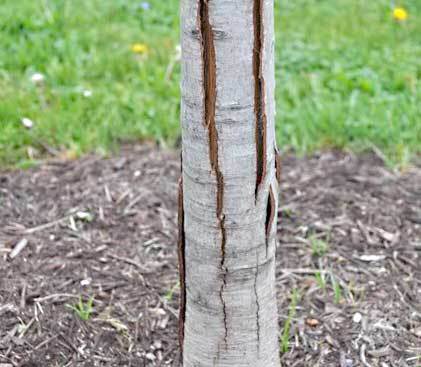
Tree damage from winter
Tree damage from winter
Extraordinary weather such as deep frost giving way to heavy rain and warm temperatures can create some big problems in the landscape. The first order of business is to access the damage on your trees. Were they swaying a bit too much during that heavy wind and rain? Did you notice a lot of branches falling? Are there splits on the sides of the bark? Vertical cracks in the bark can extend deep into the tree. Normally this happens on the south side of the tree where the sun warms the sap and begins to run but then the temperatures drop below freezing and the sap freezes in the trunk. The freezing sap and expansion that occurs can crack the bark. Normally this happens on young trees or fruit trees but it can happen to more mature trees that may have recently experienced a new level of sun or one that has experienced varied levels of drought and excessive moisture. These are all conditions we have been experiencing.
Sometimes the outer layer of bark will not peel away the first year the tree has experienced a crack. The trunk may be sunken and/or discolored. Then eventually the outer bark will lose it’s vigor and split; often times to reveal a significant injury.
The take away from this is to “plant the right plant in the right place.” I’ve said this many times. Certain trees that are more susceptible to frost cracks, such as apple, birch, crab apple, cherry, dogwood and maple should be protected from a strong sun exposure on the south or southwest side.
Other susceptible trees are ash, aspen, beech, poplar, elm, golden rain tree, honey locust, horse chestnut, linden, London plane, oak, peach, tulip tree, walnut, and willow.
Young trees can be protected in the winter with a wrap that reflects sun and keeps the trunks temperature cooler. Remember to remove the wrap in the spring after freezing weather is a distant nightmare.
Water during drought periods throughout the summer and especially during a dry fall. Going into a hard winter thirsty is not good.
Fertilize trees lightly in the spring or after the fall frosts drops the leaves.
Pruning trees in the late winter is a good thing to do to improve the canopy structure. Flowering trees can also be done in the spring after they flower but don’t forget to add this to your busy to do list.
Finally, a frost crack on your tree is not a death sentence, however, it could be susceptible to insects and diseases. If small enough a crack is a warning that there is too much exposure. It can heal itself if the conditions improve.
Naturescape can assist you in assessing tree damage from winter. As always, we are here to help and would love to assist you in any or all of your landscape dreams.
Connect with us on Facebook, Twitter, Linkedin, Instagram or email. Or call us at 860-742-0326 for the fastest service.
